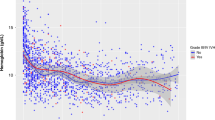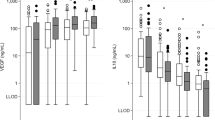Abstract
OBJECTIVE:
Markers were sought to identify the antenatal starting times and rates at which brain damage advanced in children with hypoxemic–ischemic cerebral palsy.
STUDY DESIGN:
Fetal bradycardia's onset marked the damage's start. Using this baseline, the following were tested as additional timers of the damage's onset:
-
a)
serial blood counts of neonates’ normoblasts, platelets, lymphocytes,
-
b)
differences at birth between base excess values in umbilical arterial and venous bloods,
-
c)
brain damage patterns.
RESULTS:
Each timer had a broad antenatal time frame within which it could identify specific damage starting times. The broad time frames are as follows:
-
a)
Blood lymphocyte counts: 0.45 to 13.8 hours before birth, blood normoblast counts: 0.45 to 55.0 hours before birth, blood platelet counts: 0.5 to >72 hours before birth.
-
b)
Brain damage patterns: 0.4 to >0.7 hour before birth.
Hyperventilating and hyperoxygenating neonates greatly accelerated the damage's advance.
CONCLUSIONS:
Commonly obtained laboratory values and brain images can identify when such brain damage began and the rate at which it advanced.
This is a preview of subscription content, access via your institution
Access options
Subscribe to this journal
Receive 12 print issues and online access
$259.00 per year
only $21.58 per issue
Buy this article
- Purchase on Springer Link
- Instant access to full article PDF
Prices may be subject to local taxes which are calculated during checkout





Similar content being viewed by others
References
Nelson KB . Can we prevent cerebral palsy? N Engl J Med 2003;349:1765–1769.
Clark SL, Hankins GDV . Temporal and demographic trends in cerebral palsy, fact and fiction. Am J Obstet Gynecol 2003;188:628–633.
Thacker SB, Stroup D, Chang M . Continuous electronic heart rate monitoring for fetal assessment during labor, Cochrane Database. Syst Rev 2001;2:CD000063.
Ranck JE, Windle WF . Brain damage in the monkey Macaca mulatta by asphyxia neonatorum. Exp Neurol 1959;1:130–154.
Meyers RS . Threshold values of oxygen deficiency leading to cardiovascular and brain pathological changes in term monkey fetuses. Adv Exp Med Biol 1973;37:1047–1053.
Naeye RL, Lin H-M . Determination of the timing of fetal brain damage from hypoxemia–ischemia. Am J Obstet Gynecol 2001;184:217–224.
Greisen G, Munck H, Lou H . Severe hypocarbia in preterm infants and neurodevelopmental deficit. Acta Pediatr Scand 1987;76:401–404.
Klinger G, Beyene J, Shah P, Perlman M . Do hyperoxaemia and hypocapnia add to the risk of brain injury after intrapartum asphyxia? Arch Dis Child Fetal Neonatal Ed 2005;90:F49–F52.
Volpe JJ . Hypoxic–ischemic encephalopathy: clinical aspects. In: Neurology of the Newborn. 4th ed. Philadelphia: WB Saunders Company; 2001, p. 331–394.
Vento M, Asensi M, Sastre J, et al. Oxidative stress in asphyxiated term infants resuscitated with 100% oxygen. J Pediatr 2003;142:240–246.
Laird NM, Ware JH . Random-effects models for longitudinal data. Biometrics 1982;38:963–974.
Allison PD . Survival Analysis using the SAS System: A Practical Guide. Cary NC: SAS Institute; 1995.
Naeye RL . Can meconium in the amniotic fluid injure the fetal brain? Obstet Gynecol 1995;86:720–724.
Author information
Authors and Affiliations
Additional information
Partially supported by the Gregory Alan Larach SIDS Research Fund.
Rights and permissions
About this article
Cite this article
Naeye, R., Shaffer, M. Postnatal Laboratory Timers of Antenatal Hypoxemic–Ischemic Brain Damage. J Perinatol 25, 664–668 (2005). https://doi.org/10.1038/sj.jp.7211367
Published:
Issue Date:
DOI: https://doi.org/10.1038/sj.jp.7211367
This article is cited by
-
Elevated total peripheral leukocyte count may identify risk for neurological disability in asphyxiated term neonates
Journal of Perinatology (2007)
-
Postnatal laboratory timers of antenatal hypoxemic-ischemic brain damage
Journal of Perinatology (2006)



